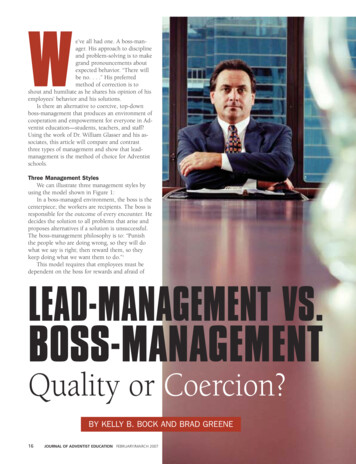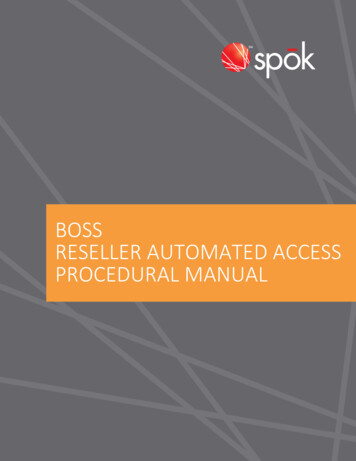
Transcription
We’ve all had one. A boss-manager. His approach to disciplineand problem-solving is to makegrand pronouncements aboutexpected behavior. “There willbe no. . . .” His preferredmethod of correction is toshout and humiliate as he shares his opinion of hisemployees’ behavior and his solutions.Is there an alternative to coercive, top-downboss-management that produces an environment ofcooperation and empowerment for everyone in Adventist education—students, teachers, and staff?Using the work of Dr. William Glasser and his associates, this article will compare and contrastthree types of management and show that leadmanagement is the method of choice for Adventistschools.Three Management StylesWe can illustrate three management styles byusing the model shown in Figure 1:In a boss-managed environment, the boss is thecenterpiece; the workers are recipients. The boss isresponsible for the outcome of every encounter. Hedecides the solution to all problems that arise andproposes alternatives if a solution is unsuccessful.The boss-management philosophy is to: “Punishthe people who are doing wrong, so they will dowhat we say is right; then reward them, so theykeep doing what we want them to do.”1This model requires that employees must bedependent on the boss for rewards and afraid ofLEAD-MANAGEMENT VS.BOSS-MANAGEMENTQuality or Coercion?BY KELLY B. BOCK AND BRAD GREENE16JOURNAL OF ADVENTIST EDUCATION FEBRUARY/MARCH 2007
Is there an alternative to coercive, top-down bossmanagement that produces an environment of cooperation and empowerment for everyone in Adventisteducation—students, teachers, and staff?punishment. Since the boss has full responsibility for planning and solutions, it is difficult to predict the level of employee accept-ance. The boss may gain minimum compliancethrough coercive techniques, but the resulting environment will negatively affect productivity. Boss-management emphasizes blind obedience rather thanthoughtful consideration of the best outcome for allconcerned. “Regardless of the skill and creativity ofthe manager, managing people depends for its ultimate success on the cooperation of the people beingmanaged.”2Laissez-faire management is characterized by a detachment between the boss and the employees (broken line). The workers are left to make individual decisions about the direction and management of theirwork. The boss may be a nice person who thinks it isimportant not to limit the personal freedom of theemployees, but this type of management provides little, if any, direction or coordination, and outcomesare unpredictable.By contrast, lead-managers collaborate with employees to create an environment of need-satisfactionand quality work. They encourage mutual respect,trust, cooperation, openness, and honesty. Management andemployees mutually explore problems, jointly agree on a solution, and work together to implement it. When conflictsFigure 1Boss-ManagementLead-ManagementLaissez-Faire ManagementbossBOSSBossWorkerWORKERworkerJOURNAL OF ADVENTIST EDUCATION FEBRUARY/MARCH 200717
arise, the boss uses a “no-guilt” approach that emphasizes the solution.Negotiation, rather than coercion, isused to solve differences. This kind ofrelationship requires the developmentand maintenance of a conviction thatall workers are committed to qualitywork and that, by working together tosatisfy their own needs, they benefitthe organization (side-by-side orientation).Lead-management promotes highself-esteem in employees, who aremuch more likely to accept management decisions because they feel asense of mutual involvement and ownership. Through positive relationships,creativity, and problem-solving skills,quality becomes everyone’s focus,rather than attempts to meet the expectations of a boss-manager or createone’s own environment in the laissezfaire management style.The Six L’s of LeadershipAnother way to depict differencesbetween boss-management and lead-Figure 2Boss-Management:BOSS privileges- threats praise- punishment rewards- withdrawal promises- referrals money- suspensionworkerFigure 3Laissez-Faire Management:bossWORKER18JOURNAL OF ADVENTIST EDUCATION FEBRUARY/MARCH 2007
management is the Cycle of Blame andthe Circle of Strength with the 6 L’s ofLeadership. In Figure 5, as people enter the Cycle of Blame, they get caughtin deadly habits such as persecuting,punishing, criticizing, and findingfault. When people choose victiming,they engage in blaming, put-downs,and criticizing; when they choose rescuing, they shift blame and put downparents, government, administration,and students.When people stay on the Circle ofStrength and choose facilitating, theyuse caring/connecting habits such aslistening, encouraging, and supporting.When they choose initiating, they askquestions to better understand the situation, model leading, cooperatively setlimits, and learn together through selfevaluating in order to achieve continuous improvement. This type of leadership makes people feel that “I want tocooperate and do my best in this or-ganization. I can trust others in this organization and feel inspired to do mybest.”Looking at the 6 L’s around the circle, moving clockwise from the top, wesee that “lead-managing” begins withLOVING and building a warm, caringenvironment. It is making others knowthat leaders care for them and will helpthem to do their best. It is expressedthrough LISTENING to others, reallyhearing their concerns, and throughFigure OpennessHonestyFigure ofBlameRescuing rningJOURNAL OF ADVENTIST EDUCATION FEBRUARY/MARCH 200719
LEVELING, by sharing legitimate concerns without blaming. When this occurs, people LEARN from one anotherand come up with more effective solutions. Educators are always LEADINGby what they say and do. Values arecaught more than taught. When LIMITS are set collaboratively, this createsbuy-in, and people are motivated tofollow initiatives that they have helpedto create.Boss-managers reverse the process,going counterclockwise, beginningwith LIMITS. A teacher enters theclassroom on the first day of the schoolyear and begins describing the rules orlimits: “This is what you can and cannot do in my classroom. When youdon’t follow my limits, I will punishyou. If you do follow my limits, I willreward you. I am here to LEAD you because I am credentialed by the stateand the church. You are here toFigure 6A1.2.3.Boss-ManagerJudges othersBlames people for problemsSays “I am not as bad as a lotof other people”4. Controls5. Takes self and others for granted6. Covers up mistakes7. Says “I only work here”8. Demands9. Builds walls10. Drives people11. Depends on authority12. Inspires fear13. Says “I”14. Gets there on time15. Fixes blame for the breakdown16. Knows how it is done17. Says “Go”18. Uses people19. Sees today20. Commands21. Never has enough time22. Is concerned with things23. Treats the symptoms24. Lets people know where he orshe stands25. Does things right26. Works hard to produce27. Creates fear28. Takes the credit29. Seeks first to be understood30. Has a win-lose approach20A Lead-ManagerAccepts othersLooks for solutionsSays “I am good but not as good as Ican be”LeadsAppreciates self and othersAdmits mistakesDoes more than the jobAsksBuilds communicationCoaches peopleDepends on cooperationInspires enthusiasmSays “we”Gets there ahead of timeFixes the breakdownShows how it is doneSays “Let’s go”Develops peopleLooks at today and the futureModelsMakes time for things that countIs concerned with peopleIdentifies and treats causesLets people know where theystandDoes the right thingWorks hard to get people to produceCreates confidence in othersGives the credit to othersSeeks first to understandHas a win-win approachJOURNAL OF ADVENTIST EDUCATION FEBRUARY/MARCH 2007LEARN, so I will LEVEL with you andtell you what, when, and how to learn.If you LISTEN to what I say, I willprobably LOVE you, and we’ll have agreat year.” That is not the way to buildhealthy relationships or a productiveclassroom.It is helpful to create mental pictures as we choose to move from bossmanagement toward lead-management.Figure 6 shows 30 paradigm shifts involved in that process. You can probably add more from your own experience.Research and Experience onManagementThe primary comparisons and contrasts are between boss-managementand lead-management, since laissezfaire management is rarely used. Theconcept of lead-management hasgrown from the work of W. EdwardsDeming, an industrial psychologistwho revolutionized the auto industryin post-World War II Japan. His ideaswere adapted and enhanced by WilliamGlasser in his books on education including The Quality School and EveryStudent Can Succeed. Glasser describesthe essentials of boss-management asfollows:“1. The boss sets the task and thestandards for what the workers (students) are to do, usually without consulting the workers. Bosses do notcompromise; the worker has to adjustto the job as the boss defines it.
“2. The boss usually tells, ratherthan shows, the workers how the workis to be done and rarely asks for theirinput as to how it might possibly bedone better.“3. The boss, or someone the bossdesignates, inspects (or grades) thework. Because the boss does not involve the workers in this evaluation,they tend to settle for just enoughquality to get by.“4. When workers resist, the bossuses coercion (usually punishment) almost exclusively to try to make themdo as they are told and, in so doing,creates a workplace in which the workers and manager are adversaries.”3Boss-management is almost entirelyconcerned with the needs of the bossrather than with those of the workers.In lead-management, on the otherhand, the manager focuses on creatinga system, using persuasion and mutualproblem-solving, that shows the workers it is their best interest to do qualitywork. Thus, the managers work on thesystem and the workers work withinthe system, with both aiming toward acommon goal of quality. Glasser describes four essential elements of leadmanagement as follows:“1. The leader engages the workersin a discussion of the quality of thework to be done and the time neededto do it so that they have a chance toadd their input. The leader makes aconstant effort to fit the job to theskills and the needs of the workers.“2. The leader (or a worker designated by the leader) shows or modelsthe job so that the worker who is toperform the job can see exactly whatthe manager expects. At the same time,the workers are continually asked fortheir input as to what they believe maybe a better way.“3. The leader asks the workers toinspect or evaluate their own work forquality, with the understanding that theleader accepts that they know a greatdeal about how to produce high-quality work and will therefore listen towhat they say.“4. The leader is a facilitator in thathe shows the workers that he has doneeverything possible to provide themwith the best tools andworkplace as well as anoncoercive, nonadversarial atmosphere in whichto do the job.”4Ellen White used theexample of Christ and Hisdisciples to illustrate whatwe strive to experience inour schools through leadmanagement. The disciples needed tobecome unified in feeling, thought,and action. “This unity it was Christ’sobject to secure. To this end He soughtto bring them into unity with Himself.”5 He did not force His will onthese disciples, but modeled what Hewished for them to do, as He patientlybrought them into His life, listened totheir needs, and created an environment of trust and growth that empowered them to evangelize the world afterHe was gone.Lead-managers . . . .encourage mutual respect,trust, cooperation, openness, and honesty.Training for Self-GovernmentIn her chapter on discipline in thebook Education, Ellen White encouraged gentle, persistent effort in teaching students to form the habit of obedience. She stated that “the object ofdiscipline is the training of the childfor self-government.”6 In addressing themanagement of schools, she warnedthat “too much management is as badas too little. The effort to ‘break thewill’ of a child is a terrible mistake.”7Despite this warning, teachers oftendescribe problems with students as battles of the will. Ellen White’s wordsdealing with teacher/student interactions can be applied to relationshipsbetween principals and staff as well.“Lead the youth to feel that they aretrusted, and there are few who will notseek to prove themselves worthy of thetrust. On the same principle it is betterto request than to command, the onethus addressed has opportunity toprove himself loyal to right principles.His obedience is the result of choicerather than compulsion.”8 These wordsdescribe the methods of lead-managersrather than boss-managers.SummaryIf quality Adventist education is ourgoal, it is imperative that those whomanage the system create an environment free from creativity-stifling fearand coercion, an environment full ofcollaboration, creativity, and cooperation. We must seek quality, not compliance; energy, not obedience. If we provide opportunities for all students,teachers, parents, constituents, and administrators to build a collaborativelearning environment, we will maximize the opportunities for each personto be a thinker and not a mere reflectorof other people’s thoughts.9 We willthus provide an environment that willtruly prepare each one for “the joy ofservice in this world and for the higherjoy of wider service in the world tocome.”10 Kelly B. BockKelly B. Bock, Ph.D.,is Director of Education forthe Pacific Union Conference of Seventh-day Adventists, Newbury Park,California. Brad Greene,Ph.D., is a Senior Facultymember at the WilliamGlasser Institute, KingsBeach, Lake Tahoe, California.REFERENCESBrad Greene1. William Glasser,Choice Theory (New York:HarperCollins Publ., Inc.,1998), p. 5.2. , TheQuality School (New York:HarperCollins Publ., Inc.,1992), p. 1
tures as we choose to move from boss-management toward lead-management. Figure 6 shows 30 paradigm shifts in-volved in that process. You can proba-bly add more from your own experi-ence. Research and Experience on Management The primary comparisons and con-trasts are between boss-management and lead-management, since laissez-











